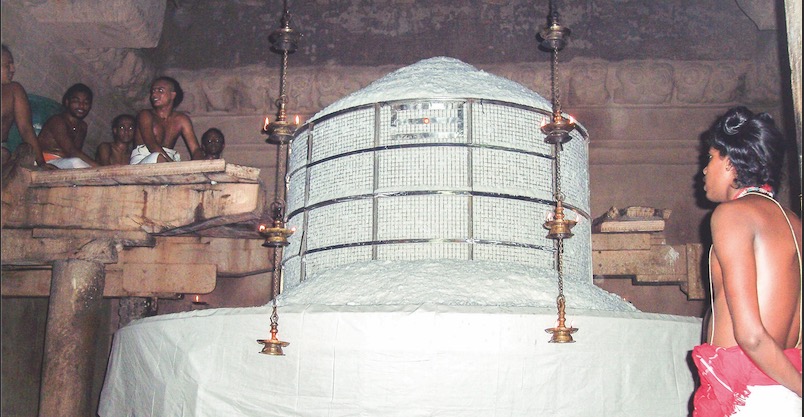ALL TOP PHOTOS: ANANTHA KRISHNAN
Source of life: The Sivalingam covered in rice
TEMPLE WORSHIP
FEEDING GOD IN GRATITUDE
______________________
A joyous ancient ritual of thanksgiving celebrates the divine source of the sustenance of our lives
______________________
BY ANANTHA KRISHNAN, TAMIL NADU
RICE IS THE STAPLE FOOD FOR US HERE in South Asia and the annabhishekam, “food bath,” with cooked rice for God Siva, is an act of thanks to the cosmic energy for providing us this magical grain. The festival is detailed by our Saiva Agamas, which tell us to cover the Sivalingam with layers of cooked, consecrated rice in the evening of the full moon day in the month of Tula (October-November). It is also believed that this annual ritual ensures plentiful food for all living beings on Earth in the coming year.
Nowhere is annabhishekam done in such grandeur as in Gangaikondacholapuram, a small sleepy village in the vicinity of Tanjavur in the southern Indian state of Tamil Nadu. The size of the ritual is due to the massive stone temple and it’s huge Sivalingam, built in 1020 CE by the King Rajendra Chola I, in this once bustling capital city of his domain.
The celebration here is a two-day affair. On the first day a complete Agamic mahabhishekam is done. All the smaller Deities in the temple corridors are washed and decorated with new clothes and sacred sandalwood, holy ash and kumkum. For Siva, the main Deity, a traditional abhishekam (bathing) is performed with the full spectrum of offerings prescribed by our scriptures: water with sandalwood paste, turmeric water, milk, orange juice, honey, coconut, yogurt, water and sacred ash—all mixed and stored in separate, huge containers. About fifteen vidyarthis, students of Vedas, stand atop scaffolding to reach the top of the massive Sivalingam, pouring over it the various mixtures while chanting “Sri Rudram.” At the end of the abhishekam, the Lord is decorated with giant flower garlands worth Rs. 10,000 ($200). The cost involved for this two-day ritual is roughly Rs. 6,00,000 ($12,000), which is raised through donations. Apart from cash, people also offer rice, often by the bag.
Four giant pots used to cook the rice; the rice piled up to cool; a human chain of volunteers line up to send baskets of cooked rice from the lower levels of the temple up to the inner sanctum where the priests use it to cover the murti
On the second day, volunteers are given yellow scarves to stand apart from hoards of people pouring in from nearby towns and villages. I was one of them. Police, barricades, a medical pavilion, a PA system broadcasting the Tirumurai songs on Lord Siva, are all in place from the break of dawn. About fifty bags (each weighing 75-100 kilograms) of top quality rice are cooked in four large vessels, powered by a massive wood stove. Shovels are used to spread out the cook rice on the floor to cool before being transferred into bamboo baskets. Some 50-60 volunteers form a line from the kitchen, up the steep stairway, all the way to the sanctum. Chanting the praise of Siva, “Om Namah Shivaya, Hara Hara Shankara,” fills the air as the baskets of rice are passed hand-to-hand in a swift and constant motion.
From 9am, throughout the day, the Vedic students chant “Sri Rudram” continuously during the annabishekam until the event slowly grinds to a halt at around 5pm. Steel mesh around the Deity holds the grain intact as the normally dark, black granite stone is transformed into a pure white Sivalingam. An assortment of vegetables decorate the top, and the final offering of light is performed with fervor running high among the gathered devotees.
As the sun descends across the western horizon, a golden glow illuminates the tall temple tower, and a sea of humanity waits in line to take home the rice as prasadam. All of God Siva’s creations, people including poor villagers, plants and animals down to critters are fed with this prasadam, not letting a single grain go to waste.
THE STUNNING CHOLA TEMPLES OF TAMIL NADU
THE CHOLA KINGS OF TAMIL NADU were among the greatest of India’s temple builders. One of India’s longest-lived dynasties, the line of rulers stretches back to 300 bce. They came into prominence in the 9th century and reigned until being overthrown by the neighboring rival Pandyas in 1279. The Cholas dedicated their wealth to the temple arts and built many giant temples, which the Pandyas left intact. Gangaikondacholapuram, the temple at the capital city built by Rajendra Chola I (1012–1044 ce), was especially beautiful.
Later, invaders began looting and destroying the temples, beginning with the Islamic raider Malik Kafur, followed by French army occupation and another Islamic attack by Arcot Nawab. The English dismantled much of the structure of Gangaikondacholapuram, taking away stones, some with inscriptions, to be used in constructing dams. Experts believe what is left of the temple today is only about half of its original form. See:kumbakonam.info
S. SRIRAMAN
Gangaikondacholapuram: A protected World Heritage Site, the temple has had extensive restoration done by the Archeological Survey of India.
